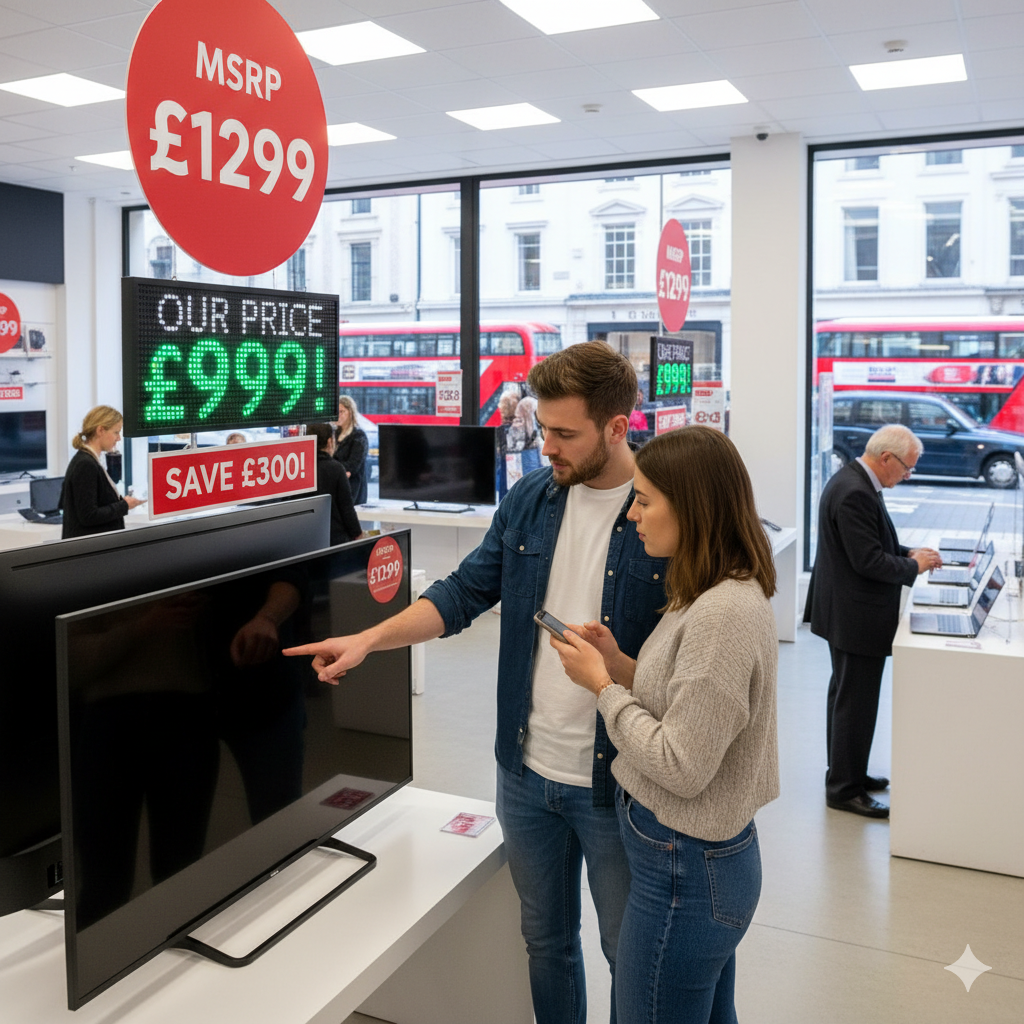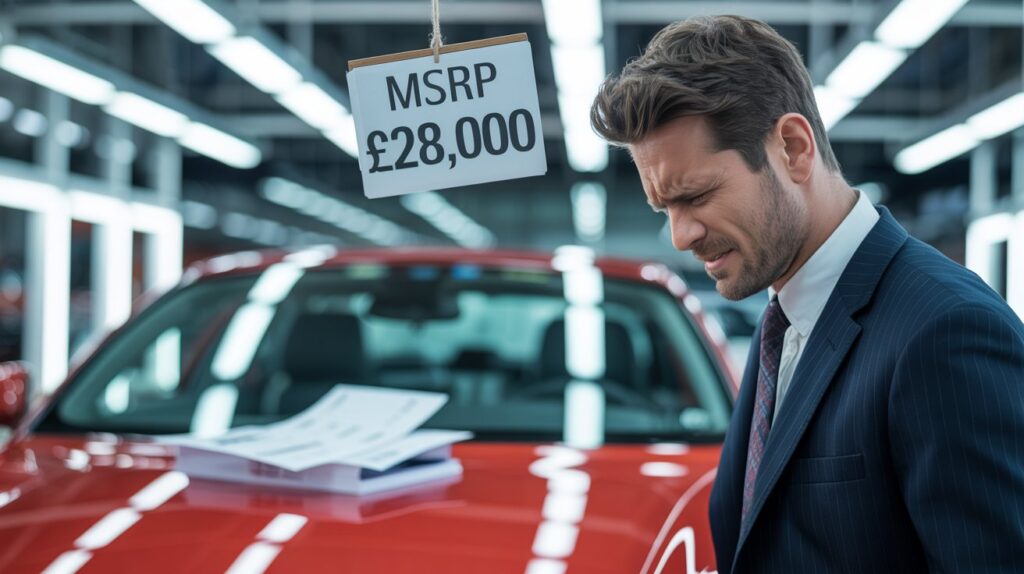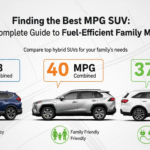

What Is MSRP? The Complete Guide for UK Shoppers
What is MSRP, and why should you care about these four little letters that could be costing you hundreds on every major purchase?
I’ll be honest with you – until recently, I had no bloody clue what MSRP meant either.
I’d see it on price tags and websites, nod knowingly like everyone else, and completely ignore it.
Big mistake.
Last month, my ignorance cost me £800 on a car purchase.
That’s when I decided to dig deep and understand exactly what manufacturers’ suggested retail prices really mean for us UK shoppers.
The Questions That Keep Shoppers Up at Night

Before we dive in, let me address the worries I hear constantly:
“Am I being ripped off because I don’t understand pricing?”
“How do I know if I’m getting a fair deal?”
“Why do identical products have completely different prices at different shops?”
“Should I trust that ‘below MSRP‘ sticker, or is it just marketing nonsense?”
If you’ve ever had these thoughts, you’re in the right place.
What Is MSRP? The Simple Answer
MSRP stands for Manufacturer’s Suggested Retail Price.
It’s exactly what it sounds like – the price that manufacturers recommend retailers should charge for their products.
Think of it like your mum suggesting you wear a coat when it’s cold outside.
She can suggest it all she wants, but you’re not legally required to listen.
The same principle applies to retailers and MSRP.
They can follow the suggestion, ignore it completely, or do whatever they fancy with pricing.
The UK Twist: RRP vs MSRP
Here in Britain, you’ll often see RRP (Recommended Retail Price) instead of MSRP.
They’re practically identical terms.
RRP is more common on British products, whilst MSRP appears on imported goods or in industries with heavy American influence.
Don’t let the different acronyms confuse you – it’s the same concept with different letters.
My £800 Mistake: A Real-World Example
Let me tell you about my car-buying disaster.
I walked into a Vauxhall dealership looking at a new Corsa.
The salesperson showed me the window sticker: “MSRP £18,000, Our Price £17,200.”
“Brilliant,” I thought, “I’m saving £800!”
I felt so clever negotiating them down to £17,000.
Two weeks later, my neighbour mentioned he’d bought the same model, same colour, same specs, for £16,200 at a different dealer.
That “discount” from MSRP wasn’t a deal at all.
It was just clever marketing that made me feel like I was winning when I was actually losing.
How MSRP Really Works: The Behind-the-Scenes Truth

Here’s what manufacturers actually do when setting suggested retail prices:
Step 1: Calculate Production Costs
They work out how much it costs to make the product, including:
- Raw materials
- Labour
- Research and development
- Marketing expenses
- Distribution costs
Step 2: Add Desired Profit Margins
Manufacturers want to make money (shocking, I know).
They’ll add their profit margin to the production cost.
Step 3: Factor in Retailer Margins
Retailers need to make money, too.
The MSRP includes enough markup so shops can offer the product at that price and still turn a profit.
Step 4: Consider Market Positioning
This is where it gets interesting.
Manufacturers use MSRP to signal where their product sits in the market hierarchy.
A £500 MSRP on headphones suggests premium quality.
A £50 MSRP suggests it is budget-friendly.
The MSRP Games Retailers Play
Once you understand these tactics, you’ll never fall for them again.
Game 1: The Artificial Inflation
Some retailers work with manufacturers to set inflated MSRPs.
Then they permanently “discount” products to create the illusion of savings.
That sofa shop that’s always having a “50% off MSRP sale”?
The sale price is probably what they wanted to charge all along.
Game 2: The Bait and Switch
Car dealers are masters of this.
They’ll advertise “below MSRP pricing” then add on:
- Extended warranties
- Paint protection
- Gap insurance
- Service packages
- Financing fees
By the time they’re finished, you’re paying well above MSRP for extras you never wanted.
Game 3: The Scarcity Shuffle
“This price is £200 below MSRP, but only for today!”
Creates false urgency based on an arbitrary suggested price.
Most of these “limited-time” offers run permanently.
Industries Where MSRP Matters Most

Automotive: The Wild West
Car pricing is absolutely mental in the UK.
Identical vehicles can vary by £3,000+ between dealers, all claiming to offer “competitive MSRP-based pricing.”
What to do: Get quotes from multiple dealers, check manufacturer incentives, and don’t be afraid to walk away.
Electronics and Technology
Tech products usually launch at or near MSRP, then drop rapidly as newer models arrive.
Buying the latest iPhone at MSRP on launch day means paying the maximum price for yesterday’s technology within months.
What to do: Wait 3-6 months after launch unless you absolutely need the latest features.
Fashion and Luxury Goods
Premium brands rarely deviate from MSRP because exclusivity is part of their appeal.
They’re probably fakes if you see genuine Gucci bags or Rolex watches significantly below MSRP.
What to do: Buy from authorised retailers and be suspicious of massive discounts on luxury items.
Home and Garden
Seasonal products like garden furniture and BBQs follow predictable pricing patterns.
MSRP is in spring when demand is high, and deep discounts are in autumn when retailers want to clear stock.
What to do: Buy end-of-season items for next year’s use.
How to Use MSRP to Your Advantage

Stop letting MSRP control you – start using it as a tool.
Research Strategy
Before any major purchase:
- Find the genuine manufacturer MSRP (check official websites, not retailer sites)
- Compare prices across multiple retailers
- Look for seasonal pricing patterns
- Check review sites to see what people actually paid
- Factor in the total cost of ownership, not just the initial price
Negotiation Tactics
Use MSRP as your starting point for negotiations:
- Know the real MSRP before entering any shop
- Research what others actually paid (not what they were quoted)
- Be prepared to walk away if the deal isn’t genuinely good
- Consider financing costs and add-ons in your calculations
Red Flag Recognition
Watch out for these warning signs:
- Prices are significantly above MSRP without a clear justification
- Pressure to buy immediately because prices might increase
- Unwillingness to show manufacturer documentation
- “Special edition” markups that add nothing of value
The Psychology of MSRP Pricing
Understanding these psychological tricks will save you money.
Anchoring Effect
When you see a high MSRP first, everything else seems reasonable by comparison.
Even if the “discounted” price is still expensive, your brain perceives it as a bargain.
Social Proof
“Most of our customers are happy to pay MSRP for this quality.”
This suggests you should be willing to pay full price, too, even when smarter shoppers are getting deals.
Loss Aversion
“Save £500 off MSRP today only!”
Your brain focuses on the money you might lose by not buying, rather than questioning whether the original MSRP was fair.
MSRP in the Digital Shopping Era
Online shopping has completely changed the MSRP landscape.
Price Comparison Made Easy
Websites like PriceRunner and Google Shopping make it impossible for retailers to hide pricing games.
You can instantly see who’s following MSRP and who’s taking liberties.
Dynamic Pricing Systems
Many online retailers adjust prices constantly based on:
- Competitor pricing
- Demand levels
- Inventory levels
- Your browsing history
- Time of day/week
That MSRP becomes just one factor in a complex pricing algorithm.
Direct-to-Consumer Revolution
Brands selling directly to customers often bypass traditional retail markups entirely.
Their “MSRP” might actually represent better value than products going through traditional retail channels.
Common MSRP Mistakes That Cost Money
Mistake 1: Assuming MSRP Equals Fair Value
Just because a manufacturer suggests a price doesn’t mean it’s reasonable.
Some companies set artificially high MSRPs to make retailer prices look attractive.
Mistake 2: Not Shopping Around
I see people constantly buying the first product they find at MSRP without checking alternatives.
Fifteen minutes of research can save hundreds.
Mistake 3: Focusing Only on MSRP Discounts
A 20% discount from an inflated MSRP might still be more expensive than competitors’ regular prices.
Focus on total value, not percentage savings.
Mistake 4: Ignoring Long-term Costs
MSRP only covers the purchase price.
Smart shoppers factor in maintenance, insurance, depreciation, and running costs.
Industry Insider Secrets
Wholesale vs MSRP Reality
Most retailers pay 40-60% of MSRP for their products.
That “10% discount” still gives them healthy profit margins.
Seasonal Pricing Cycles
Manufacturers often adjust MSRP seasonally to help retailers manage inventory.
What looks like a great deal might just be the new, lower MSRP.
Volume Discount Programs
Large retailers often get volume discounts that allow them to profit while selling below MSRP.
Independent shops might struggle to match these prices while remaining profitable.
Frequently Asked Questions
Is paying MSRP always a rip-off?
Not necessarily.
For brand-new, high-demand products, MSRP might be the best available price.
The key is knowing whether you’re getting genuine value for money.
Can manufacturers force retailers to charge MSRP?
Generally, no.
However, manufacturers can use tactics like limiting supply or ending relationships with retailers who consistently undercut pricing.
How do I find the real MSRP?
Check the manufacturer’s official website first.
Be suspicious of MSRPs listed on retailer sites – they might inflate them to make their prices look better.
Should I always negotiate below MSRP?
It depends on the product and industry.
Cars, furniture, and some electronics have negotiation room.
Groceries, books, and most everyday items typically don’t.
What’s considered a good discount from MSRP?
This varies by industry:
- Automotive: 5-15% below MSRP is often achievable
- Electronics: 10-30% below MSRP is common after the launch period
- Furniture: 20-50% “discounts” are standard (but MSRPs are often inflated)
- Luxury items: Expect to pay at or near MSRP from authorised dealers
Do online prices differ from in-store MSRP pricing?
Often, yes.
Online retailers typically have lower overhead costs and face more direct competition.
Physical stores might stick closer to MSRP to maintain margins that cover rent and staff costs.
How often do manufacturers change their MSRP?
It varies by industry and product lifecycle:
- Technology: Often drops every 6-12 months as newer models arrive
- Automotive: Usually annual adjustments with model year changes
- Fashion: Seasonal adjustments, with end-of-season clearances
- Home goods: Less frequent, often tied to material cost changes
My Bottom Line on MSRP
Here’s what I wish someone had told me before that expensive car purchase:
MSRP is just one piece of the pricing puzzle.
Smart shoppers use it as a research starting point, not as the final word on value.
The goal isn’t to find products at MSRP – it’s to understand what represents genuine worth for your specific needs and budget.
Don’t let retailers use MSRP to manipulate your emotions or rush your decisions.
Do your homework, compare options, and remember that the best deal isn’t always the lowest price – it’s the one that delivers the most value for your circumstances.
Next time you see an MSRP sticker, you’ll know exactly how to use that information to your advantage rather than letting it be used against you.
Now you know what MSRP is and how to make it work for you instead of against you.
Add a comment Cancel reply
Categories
- Auto Detailing (3)
- Car News (1)
- Car Reviews (10)
- Uncategorized (2)
Recent Posts
About us

Popular Tags
Related posts










